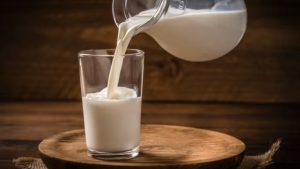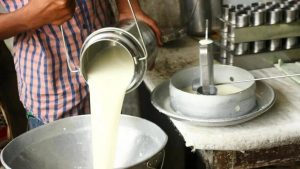
Following is a transcript of the video.
Narrator: Cows produce the majority of the world’s milk. But beyond cows, there are animals from all around the world that contribute to the production of milk based on environmental differences. For example, water buffalo produce milk in wet, tropical regions, and camels produce milk in dry regions. With a variety of dairy animals comes a variety of uses for each milk. Let’s take a look at how milk is utilized around the world. Somalia and Kenya are the largest producers of camel milk in the world.
Narrator: Camels are an ideal dairy-producing animal for arid and low-moisture environments, as camels are able to go over a week without drinking water. Herders occasionally survive on only camel milk while taking camels vast distances to graze. In commercial-camel-milk settings, camels can produce 5 to 20 liters a day. Camel milk tastes similar to cow milk, but typically it’s creamier and slightly saltier. India and Pakistan produce about 80% of all buffalo milk worldwide, making these regions one of the few places in the world where cows are actually in the minority when it comes to dairy production.
Narrator: Water buffalo can produce more milk than cows, and their milk is also thicker and whiter. Buffalo milk is used to make Surti paneer, a soft cheese that borrows its name from the town of Surat in India, where this specific paneer is thought to have originated.
Narrator: Sahiwal is another animal that has most of its milk produced in India and Pakistan. Sahiwal originated in the dry Punjab region, which lies along the central Punjab. Sahiwal are a type of cow but have a distinctive large hump on their back. Due to their heat tolerance and high milk production, sahiwals are one of the best dairy breeds in India and Pakistan. Kalari cheese is a traditional ripened cheese product indigenous to Rajouri, Poonch, and Udhampur in India’s Jammu and Kashmir region. It’s a very dense cheese that is usually sautéed in its own fat and salted while serving.
Narrator: Kumis, or airag, is a drink native to Mongolia traditionally made from fermented horse milk, and it’s been consumed for centuries. It’s made by fermenting mare’s milk over the course of a day or two, intermittently churning the milk throughout the fermentation process. The final product has a slightly sour taste, and it’s a little bit alcoholic, but only around 2%.
Narrator: Yaks are domestic to the Himalayan region, providing many amenities such as wool, meat, and of course milk. Yak milk has a higher fat and protein content than that of cows. This is one of the reasons why yak butter is highly sought after in some circles. Because yaks produce more milk in the summer than the winter, yak milk is often turned into butter or cheese in order to preserve it for later. One of those cheeses is chhurpi, which comes in soft or extremely hard variants.
Narrator: Goat milk is a staple of French cuisine, contributing to many of the wide variety of cheeses produced in France. Goat milk is also used to make soap, which can be a gentle cleanser that keeps skin moisturized by not stripping it of natural fats. Goat milk is also a good source of vitamin A, which is known to preserve eyesight, support organ function, and even help the immune system. Narrator: Reindeer milk is very rare, and only a few places in Scandinavia actually milk reindeer. Reindeer milk has a shocking 20% fat content, compared to the average 3.5% for cows, but that fat content gives the milk a very rich and creamy taste. Reindeer can be milked for only about 1 1/2 cups per day. Reindeer milk can be turned into leipäjuusto, a traditional hard cheese from Finland with a milky taste. Sometimes in Sweden, it’s put into cups of coffee.
Narrator: Greece is known for its dairy products, such as sheep’s milk. Sheep’s milk is extremely high in fat content and has a high level of solids, which makes it ideal for cheesemaking. Sheep’s milk tastes rich and buttery and has a less sharp aftertaste than cow’s milk. One of the most common cheeses made from sheep’s milk is feta. Because of its high calcium content, feta can also help maintain healthy teeth and bones.
Narrator: Headlines proclaim donkey milk great for both nutrition and cosmetic products. Donkey milk has been used for centuries. It’s even said that Cleopatra bathed in donkey’s milk in order to preserve her beauty and the youthful look of her skin. As for its taste, it’s similar to skim milk. Many people find that it’s much easier for humans to digest than cow’s milk.
Narrator: Moose milk is very uncommon, but it is commercially available in Russia and Sweden. Moose only produce between 1 and 6 liters per day, but their milk is much higher in fat and protein than cow’s milk. There is thought to be only one producer of moose cheese in the world, the Älgens Hus in the Bjurholm region of Sweden, where it has three moose. Moose cheese is one of the most expensive in the world and can cost as much as $500 per pound.
Advertisement
Narrator: So, which animal milk or products do you want to try? Let us know in the comments below.

















